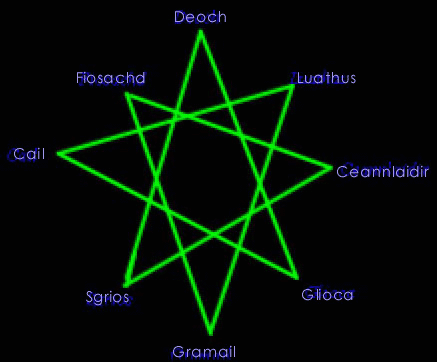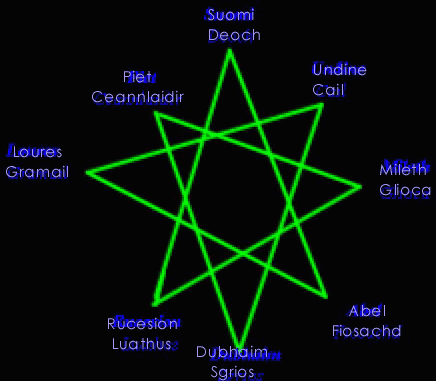
In the age when gods used men as mere pawns, there was, nevertheless, a strong attachment and respect for those beings given more vision and power than mere mortals. I gather there always will be a deep respect for them. Gods do change over time though as does man. People always interpret the messages of their gods differently, and thus conflict and religious wars begin over petty incidents that no one remembers how they had begun. The enmity men hold in their hearts becomes a tradition. It was the same when these temples and shrines were first created. It happened at, what I like to call, "The Great Rift." That is rather to say, when Deoch fell in love with Danaan in Danaan 3113..
![]()
Now one would not normally attribute a name such as
"The Great Rift" to the joining of two hearts,
but in truth it caused much more turmoil than the gods
had imagined they could. Followers of Deoch felt
betrayed. They were sickened that their beloved
debauchery could turn to the light. Followers of
Glioca were shocked and suspicious, as Glioca was as
Danaan's right hand and closely tied to her. They
could not believe that a follower of Chadul could change
heart so easily. They did not think one of Chadul
even had a heart. Followers of Sgrios had murder
fill their eyes, as not only did Deoch now threaten to
shake the balance towards the light, but they felt Deoch
was like their brethren, a fellow servant of
Chadul. They felt hatred towards Glioca and Danaan
as well for they felt that Danaan had seduced the old
debaucher, not that he chose Danaan willingly.
Followers of Ceannlaidir, who loved the war that was
already occurring and thirsted for more, spurned on the
three groups into conflict. A fatal flaw as it
turned out.
The old followers of the Deoch church actively went out in inquisition, burning and torturing any they felt were heretics and blasphemers to their cause by supporting the new Deoch. The Gliocan church too was torn asunder by those who would accept the new follower of light and those that believed Deoch too sinister to turn. Then Sgrios spurned on destruction. A massive hailstorm filled the sky and tore down both the temple of Glioca and Deoch. Something snapped in all the groups at that point, and a massive sweep "purged" the land. Now listening to Sgrios's theory, Gliocans found themselves thinking the opposite: that Deoch seduced Danaan. Spurned by the memory of seduction, their thoughts turned to Ceannlaidir who seduced Glioca. The temple was torn. Deochians now thought that Deoch had learned of something, and knowledge was evil. Thus the Luathans became involved.
The guards were overwhelmed by this
onslaught, but no one bothered to see them making the
effort. The Luathans as well as Ceannlaidir stated
that the law was to blame for the destruction of their
shrines and destroyed the Gramailians place of
worship. Cail followers tried to calm the masses,
but those of Ceannlaidir accused them of trying to
overthrow them as the god himself feared. Then
hysteria spread, and they blamed the cursed rogues of
Fiosachd, who had swiftly went into hiding over this
war. Luckily, all the worshippers escaped but the
last of the temples was destroyed. It wasn't until
the Dubhaimid launched their largest assault 2 Danaans
later that the blood feud that had begun would end.
The damage had already been done, and all religions were
left without a place of worship.
![]()
It was not until Danaan sacrificed herself, and Deoch
took over Her works that people slowly started to see the
fools they'd been. Simply because they stopped
fighting was no reason for them to look back in
retrospect and see their folly. There was simply a
greater threat then and differences were put aside
temporarily. Now that most of the threats were gone
and strange new creatures named aislings were beginning
to populate the world, people actually started to see
what Deoch was aiming to accomplish. So in the
middle of Deoch 1, they agreed to all put their heads and
efforts together to restore the temples, a project that
would in the end last for 3 years.
The first year went into planning. Some may look at
the temples and simply think them thrown together, but I
believe there was rather a lot of thought put behind
them. I would not remember discussions during this
period, so what follows is a bit speculation but it is
sound.
Now the first temple do decide upon was the one dedicated
to the new gift shared. This was the Shrine to
Deoch. Since Deoch was now the newly born god of
light, this area was chosen because it is the farthest
known land that sees the last light of day. The sun
sets later in Suomi than anywhere else and hides behind
the mountains, which spray red light through the shrine's
pillars and into the main chamber. The shrine was
specifically built to best catch this effect.

![]()
Going from here, the other temples seem to somewhat
reflect the nature of the god. Fiosachd is placed
at the center of commerce, Gramail at the center of the
kingdom's law, Sgrios in the castle of the
Dubhaimid. However, this is not the only order to
the planning. If we look at the octagram that the
mundane priestesses give us, we come up with this:
This star was covered quite thoroughly in Chloe's
philosophical work, Reflections. The gods next to
each other are enemies, while the one with lines drawn
connecting are allies. Also, ones directly across
from each other are opposites. However, some of
these seem a bit less direct opposites than others.
As I looked at it further, it seemed that these were more
and more how the gods related with each other.
I was looking over a map one day when it dawned on me...a
new theory. I looked closer at the eight temple
areas and their arrangement drew me. I eventually
took out a brush and lightly made a few marks on the maps
to all the towns and places which had a temple. I
had to draw to the outskirts of some but I came up with
the figure that ye see here:
 |
It is rough (since the map is flat but our world is not
so clear cut) but an octagram is formed! The
placing of the temples was indeed not a
coincidence. It seems this position holds the most
power for religion. Now we can organize the temples
of this octagram the same way we did the priestial
lecture, by placing Deoch on top. With that, we
achieve this octagram:

![]()
Now this octagram is quite different from the other, and
is sometimes difficult to see how it relates. It is
important to remember, though, that the other is the
interaction of the gods with each other. The
mundanes building the shrines saw them as a bridge.
This bridge was one that tied the gods with man.
And thus this octagram creates its pattern and begins to
make sense.
At the poles of each points are the opposing elements of
the society:
Rebirth and creation (Deoch) versus death and destruction
(Sgrios),
Natural instinct and impulse (Cail) versus cold reason
and logic (Luathas),
Indifferent mercy (Glioca) versus legal punishment
(Gramail),
And pure luck (Fiosachd) versus military tactics and
planning (Ceannlaidir).
Although they might not have a direct enmity against each
other as far as gods, the elements in society contrast
each other.
I further observed this second star and noticed the
connection. Each line was an equation, and they
converged to a point where the elements combined to some
element of that other god. This is a bit more
difficult to see. On the left side, I shall put the
statement and on the right, I shall put the equation of
the gods that statement refers to:
Chance and luck when attributed to facts can yield
creativity. (Fiosachd + Luathas = Deoch)
Nature's law (survival of the most fit) can be defined as
an order or law attributed to death. (Cail = Gramail +
Sgrios)
When someone obtains knowledge of their military enemy,
this can lead to mercy. (Luathas + Ceannlaidir = Glioca)
If one is creative in interpreting law, they see it as
the luck of them not being caught. (Deoch + Gramail =
Fiosachd)
Nature's survival instinct in war leads to someone's
death. (Cail + Ceannlaidir = Sgrios)
Love of creativity is what spurns the quest for
knowledge. (Glioca + Deoch = Luathas)
Nature paired with dexterity and luck is also Nature's
law (Cail + Fiosachd = Gramail)
Love of country paired with death is what can start a war
(Glioca + Sgrios = Ceannlaidir)
Looking at it this way, the planning makes a bit of
sense. The gateway to the gods also shows how
mundanes interpreted the gods' messages. This would
explain well the pattern that is seen.
![]()
In addition, there is a split by the mountains between
the two, that has been called "The Holy
Divide". The "warmer" gods (Deoch,
Cail, Glioca, and Fiosachd) are divided in the north
while the "colder" gods (Ceannlaidir, Gramail,
Luathas, and Sgrios) are on the southern end.
I use these terms "warmer" and
"colder" loosely. The "warmer"
gods are those that seem concerned with humanity, while
the "colder" ones take a more indifferent view
towards aislings and mundanes. The warm elements
are Glioca's concept of mercy and love, Fiosachd's
concern with things of chance and wealth (animals have no
need of wealth), Deoch's want of the creative spark and
aislings, and Cail's look at harmony in people and all
things. The cold elements are then Sgrios'
unyielding grip on death, Luathas's facts forgoing
emotion, Gramail's hard and fixed view on law, and
Ceannlaidir indifference towards the sides in battle.
![]()
After a Deoch of planning where the temples should be
built, the mundanes began to work. The construction
went surprisingly well. The stones were picked
carefully and the religions worked together.
Enmities were put aside as the foundation and pillars
were set. The only ones who refused to help were
the Sgrios worshippers, since construction was utterly
opposed to the destruction they prayed for. They
went about creating their temple in an opposite manner,
by destroying some of the rock below the Dubhaim castle
to build their shrine. Construction was finished
within 2 Deochs (At Deoch 4) and the shrines of worship
were complete once more.